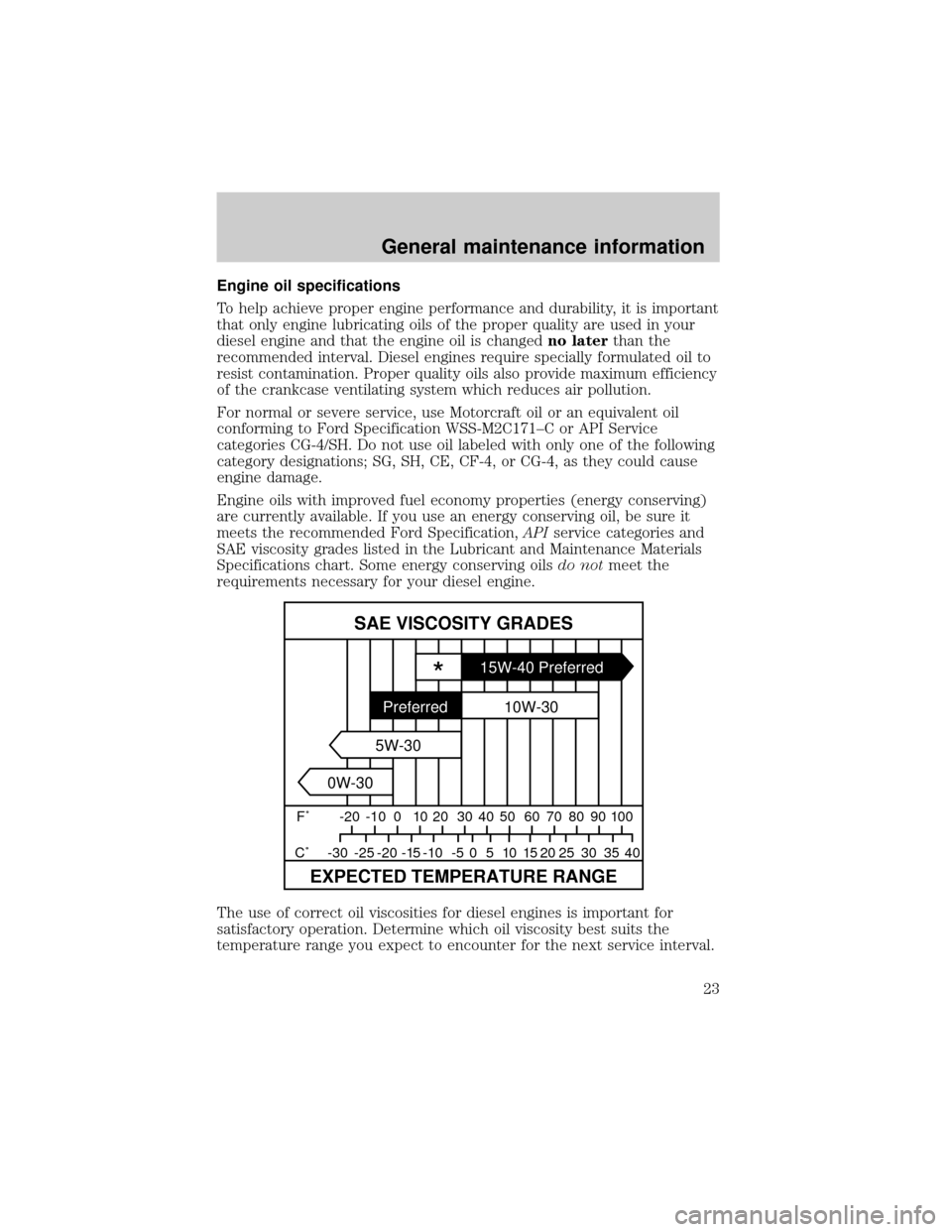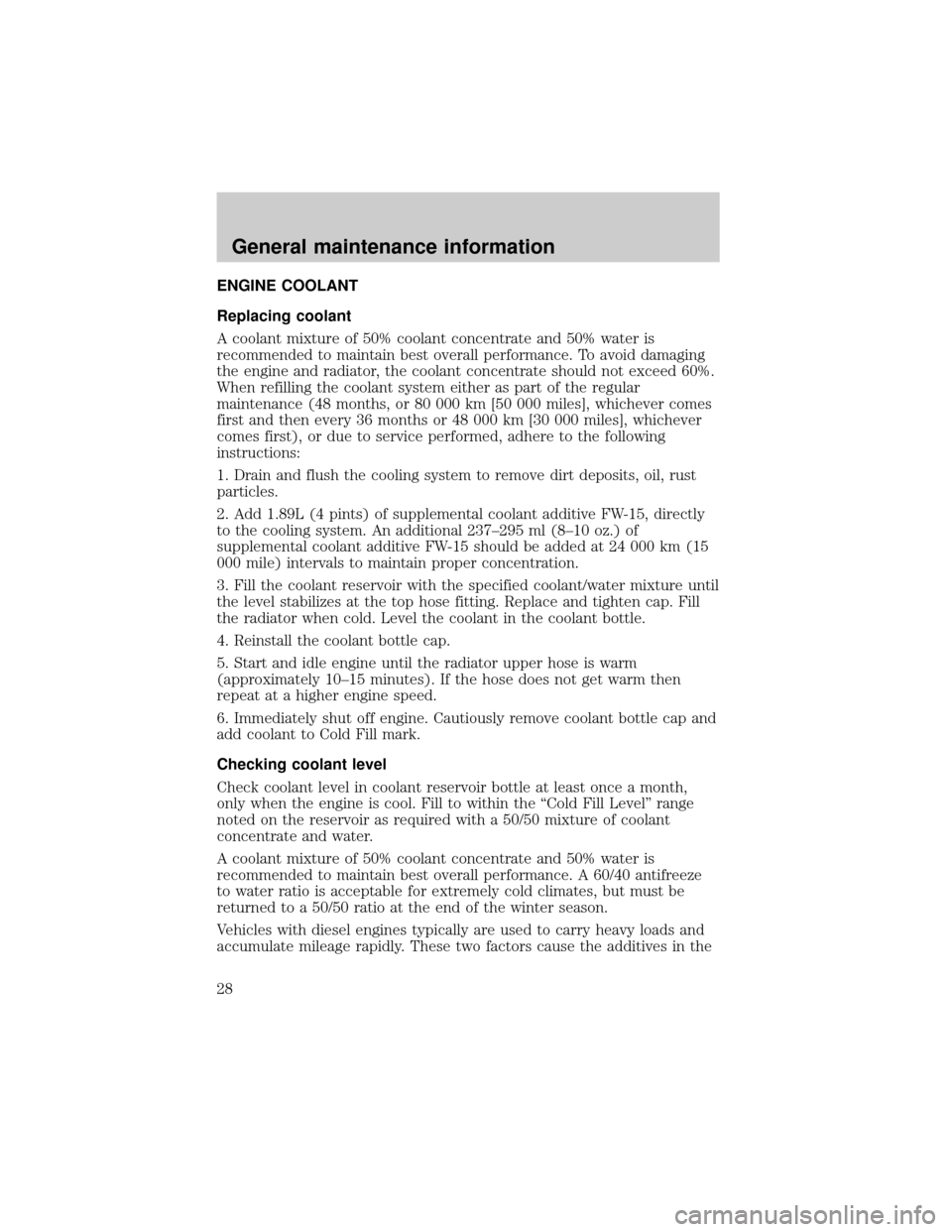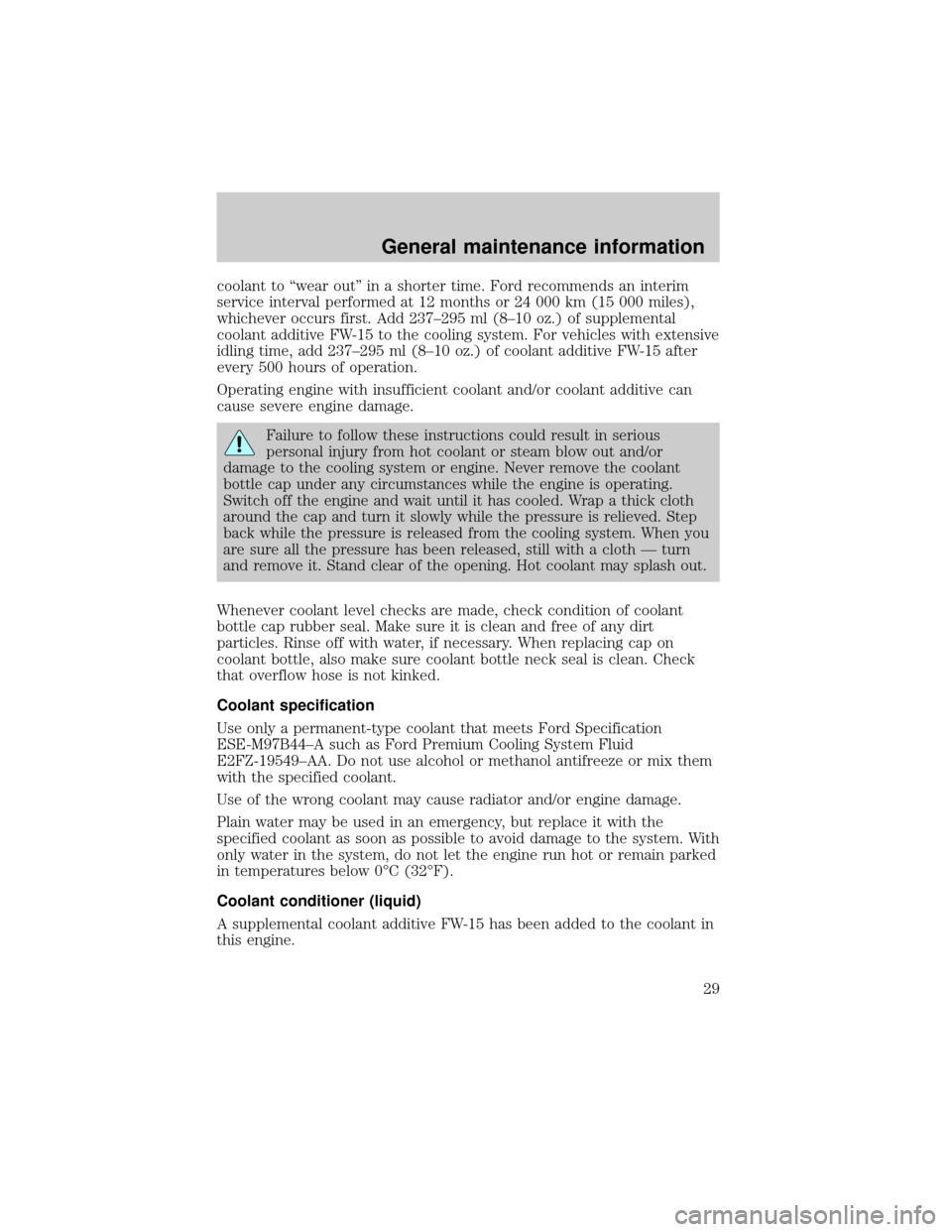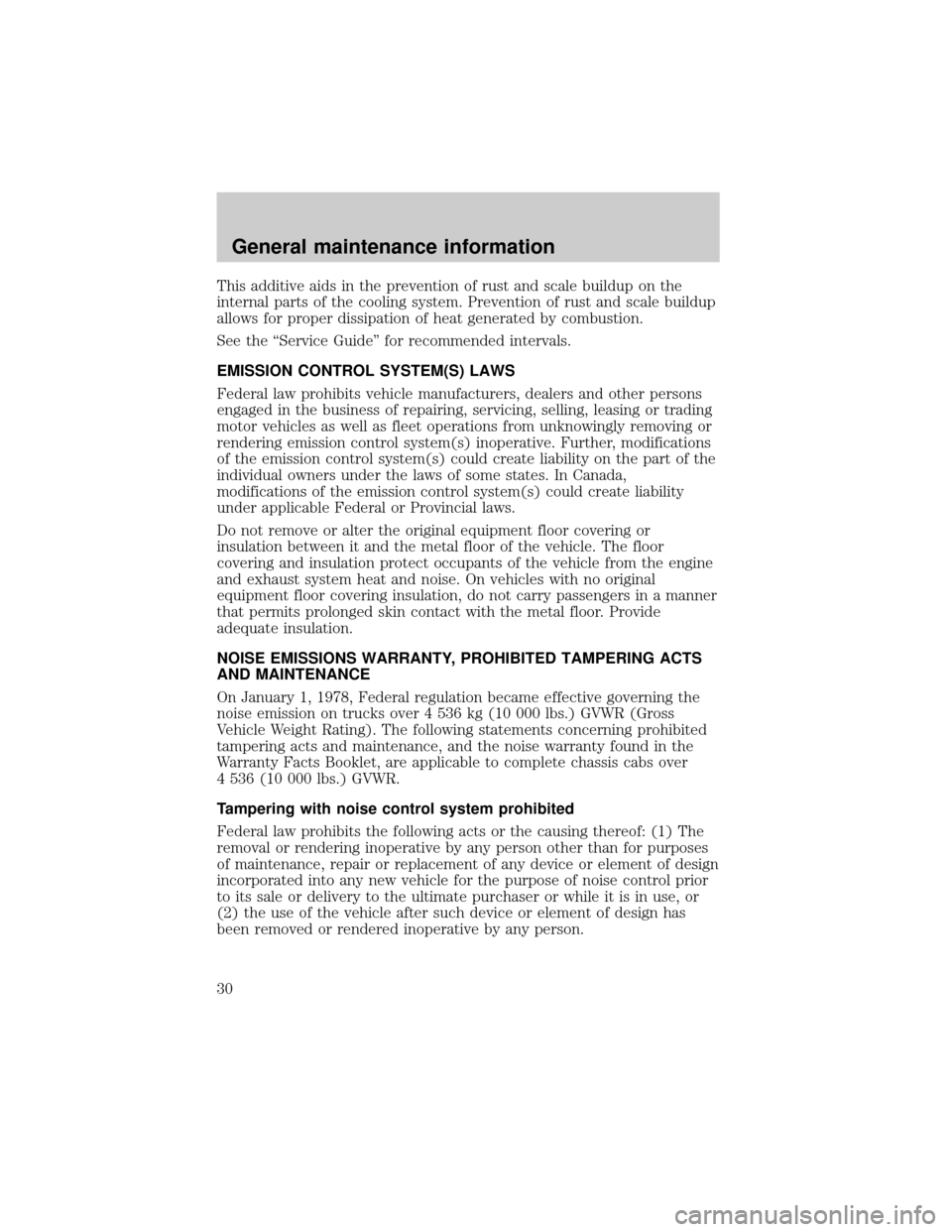1999 FORD E SERIES service interval
[x] Cancel search: service intervalPage 4 of 39

DIESEL ENGINE INFORMATION
The diesel engine fuel system consists of:
²a frame-mounted electric fuel supply pump
²an engine mounted fuel filter/water separator
²a fuel restriction sensor
²a unit injector for each cylinder
The combination fuel filter/water separator removes both water and
impurities from the fuel. The filter should be changed at the
recommended service interval. Refer to the ªService Guideº for more
information. The filter bowl should be drained at regular intervals or
when the ªWATER IN FUELº light illuminates in the instrument cluster.
The fuel injectors are located in the center of the combustion chambers
in the cylinder head between the rocker arm assemblies. The glow plug
system and fuel injection system are controlled through the powertrain
control module (PCM).
Fuel is drawn from the fuel tank by a frame-mounted electric fuel pump.
The fuel pump provides pressurized fuel to the engine and is
electronically controlled by the fuel pump PCM relay. The fuel pump
contains a pressure relief valve for overpressure protection in the event
of restricted flow.
Lubrication system
It is important to change the engine oil at the recommended service
intervals, because oil viscosity is important in maintaining the oil
pressure required to actuate the fuel injectors. Extended oil change
intervals can negatively affect engine performance and fuel economy.
The turbocharger, which is supplied pressurized oil, is also used to
actuate an exhaust backpressure warm-up system (if equipped).
Pressurized oil returning to the turbocharger is routed to the exhaust
backpressure actuator. During exhaust backpressure operation, the
engine's sound will be altered and you may notice a change in engine
performance while it's engaged. This function occurs only during cold
weather warm-up cycle.
Diesel information
4
Page 23 of 39

Engine oil specifications
To help achieve proper engine performance and durability, it is important
that only engine lubricating oils of the proper quality are used in your
diesel engine and that the engine oil is changedno laterthan the
recommended interval. Diesel engines require specially formulated oil to
resist contamination. Proper quality oils also provide maximum efficiency
of the crankcase ventilating system which reduces air pollution.
For normal or severe service, use Motorcraft oil or an equivalent oil
conforming to Ford Specification WSS-M2C171±C or API Service
categories CG-4/SH. Do not use oil labeled with only one of the following
category designations; SG, SH, CE, CF-4, or CG-4, as they could cause
engine damage.
Engine oils with improved fuel economy properties (energy conserving)
are currently available. If you use an energy conserving oil, be sure it
meets the recommended Ford Specification,APIservice categories and
SAE viscosity grades listed in the Lubricant and Maintenance Materials
Specifications chart. Some energy conserving oilsdo notmeet the
requirements necessary for your diesel engine.
The use of correct oil viscosities for diesel engines is important for
satisfactory operation. Determine which oil viscosity best suits the
temperature range you expect to encounter for the next service interval.
SAE VISCOSITY GRADES
EXPECTED TEMPERATURE RANGE
F˚ -20 -10 0 10 20 30 40
40 35 30 25 20 15 10 5 0 -5 -10 -15 -20 -25 -30 C˚50 60 70 80 90 100
*15W-40 Preferred
10W-30
5W-30
0W-30Preferred
General maintenance information
23
Page 28 of 39

ENGINE COOLANT
Replacing coolant
A coolant mixture of 50% coolant concentrate and 50% water is
recommended to maintain best overall performance. To avoid damaging
the engine and radiator, the coolant concentrate should not exceed 60%.
When refilling the coolant system either as part of the regular
maintenance (48 months, or 80 000 km [50 000 miles], whichever comes
first and then every 36 months or 48 000 km [30 000 miles], whichever
comes first), or due to service performed, adhere to the following
instructions:
1. Drain and flush the cooling system to remove dirt deposits, oil, rust
particles.
2. Add 1.89L (4 pints) of supplemental coolant additive FW-15, directly
to the cooling system. An additional 237±295 ml (8±10 oz.) of
supplemental coolant additive FW-15 should be added at 24 000 km (15
000 mile) intervals to maintain proper concentration.
3. Fill the coolant reservoir with the specified coolant/water mixture until
the level stabilizes at the top hose fitting. Replace and tighten cap. Fill
the radiator when cold. Level the coolant in the coolant bottle.
4. Reinstall the coolant bottle cap.
5. Start and idle engine until the radiator upper hose is warm
(approximately 10±15 minutes). If the hose does not get warm then
repeat at a higher engine speed.
6. Immediately shut off engine. Cautiously remove coolant bottle cap and
add coolant to Cold Fill mark.
Checking coolant level
Check coolant level in coolant reservoir bottle at least once a month,
only when the engine is cool. Fill to within the ªCold Fill Levelº range
noted on the reservoir as required with a 50/50 mixture of coolant
concentrate and water.
A coolant mixture of 50% coolant concentrate and 50% water is
recommended to maintain best overall performance. A 60/40 antifreeze
to water ratio is acceptable for extremely cold climates, but must be
returned to a 50/50 ratio at the end of the winter season.
Vehicles with diesel engines typically are used to carry heavy loads and
accumulate mileage rapidly. These two factors cause the additives in the
General maintenance information
28
Page 29 of 39

coolant to ªwear outº in a shorter time. Ford recommends an interim
service interval performed at 12 months or 24 000 km (15 000 miles),
whichever occurs first. Add 237±295 ml (8±10 oz.) of supplemental
coolant additive FW-15 to the cooling system. For vehicles with extensive
idling time, add 237±295 ml (8±10 oz.) of coolant additive FW-15 after
every 500 hours of operation.
Operating engine with insufficient coolant and/or coolant additive can
cause severe engine damage.
Failure to follow these instructions could result in serious
personal injury from hot coolant or steam blow out and/or
damage to the cooling system or engine. Never remove the coolant
bottle cap under any circumstances while the engine is operating.
Switch off the engine and wait until it has cooled. Wrap a thick cloth
around the cap and turn it slowly while the pressure is relieved. Step
back while the pressure is released from the cooling system. When you
are sure all the pressure has been released, still with a cloth Ð turn
and remove it. Stand clear of the opening. Hot coolant may splash out.
Whenever coolant level checks are made, check condition of coolant
bottle cap rubber seal. Make sure it is clean and free of any dirt
particles. Rinse off with water, if necessary. When replacing cap on
coolant bottle, also make sure coolant bottle neck seal is clean. Check
that overflow hose is not kinked.
Coolant specification
Use only a permanent-type coolant that meets Ford Specification
ESE-M97B44±A such as Ford Premium Cooling System Fluid
E2FZ-19549±AA. Do not use alcohol or methanol antifreeze or mix them
with the specified coolant.
Use of the wrong coolant may cause radiator and/or engine damage.
Plain water may be used in an emergency, but replace it with the
specified coolant as soon as possible to avoid damage to the system. With
only water in the system, do not let the engine run hot or remain parked
in temperatures below 0ÉC (32ÉF).
Coolant conditioner (liquid)
A supplemental coolant additive FW-15 has been added to the coolant in
this engine.
General maintenance information
29
Page 30 of 39

This additive aids in the prevention of rust and scale buildup on the
internal parts of the cooling system. Prevention of rust and scale buildup
allows for proper dissipation of heat generated by combustion.
See the ªService Guideº for recommended intervals.
EMISSION CONTROL SYSTEM(S) LAWS
Federal law prohibits vehicle manufacturers, dealers and other persons
engaged in the business of repairing, servicing, selling, leasing or trading
motor vehicles as well as fleet operations from unknowingly removing or
rendering emission control system(s) inoperative. Further, modifications
of the emission control system(s) could create liability on the part of the
individual owners under the laws of some states. In Canada,
modifications of the emission control system(s) could create liability
under applicable Federal or Provincial laws.
Do not remove or alter the original equipment floor covering or
insulation between it and the metal floor of the vehicle. The floor
covering and insulation protect occupants of the vehicle from the engine
and exhaust system heat and noise. On vehicles with no original
equipment floor covering insulation, do not carry passengers in a manner
that permits prolonged skin contact with the metal floor. Provide
adequate insulation.
NOISE EMISSIONS WARRANTY, PROHIBITED TAMPERING ACTS
AND MAINTENANCE
On January 1, 1978, Federal regulation became effective governing the
noise emission on trucks over 4 536 kg (10 000 lbs.) GVWR (Gross
Vehicle Weight Rating). The following statements concerning prohibited
tampering acts and maintenance, and the noise warranty found in the
Warranty Facts Booklet, are applicable to complete chassis cabs over
4 536 (10 000 lbs.) GVWR.
Tampering with noise control system prohibited
Federal law prohibits the following acts or the causing thereof: (1) The
removal or rendering inoperative by any person other than for purposes
of maintenance, repair or replacement of any device or element of design
incorporated into any new vehicle for the purpose of noise control prior
to its sale or delivery to the ultimate purchaser or while it is in use, or
(2) the use of the vehicle after such device or element of design has
been removed or rendered inoperative by any person.
General maintenance information
30